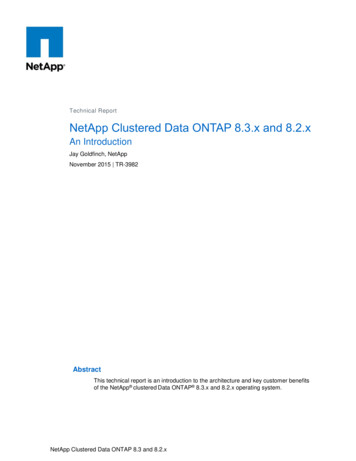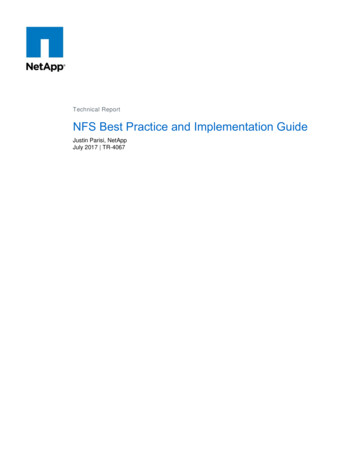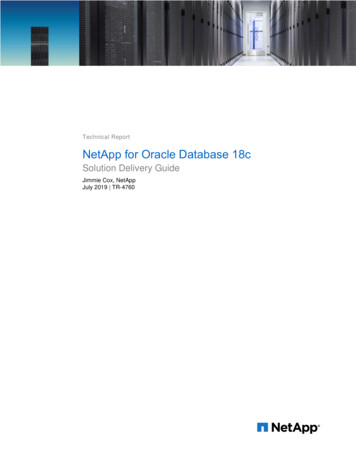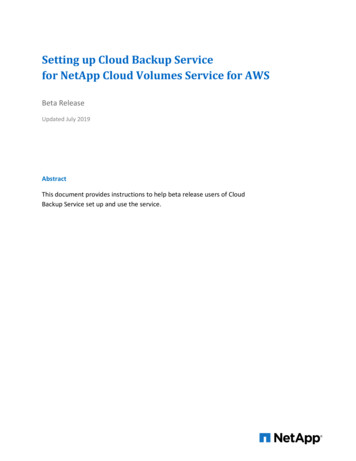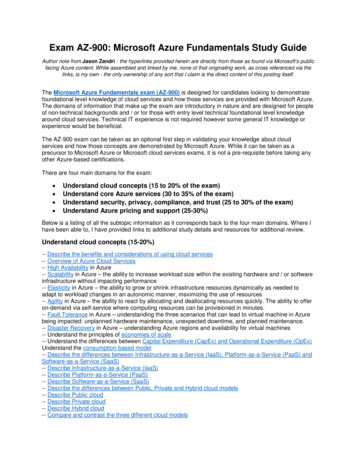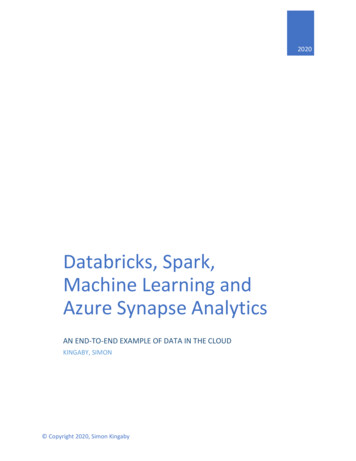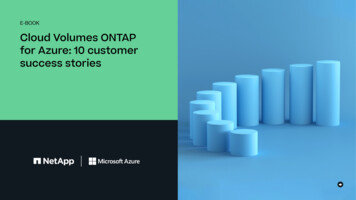
Transcription
E-BOOKCloud Volumes ONTAPfor Azure: 10 customersuccess stories
Contents1. Executive summary22. Introduction33. Cloud use cases: Drivers and benefits44. Why use Azure for entertise?55. Cloud storage challenges66. Cloud volume ONTAP customer success stories on Azure77. Get more from Azure with Cloud Volumes ONTAP181
Executive summaryAs the shift towards the cloud continues, enterprises that still need to choosea cloud provider, or who are thinking of moving to a new one, have difficultdecisions to make when it comes to their storage demands. Will the new cloudplatform provide for all the enterprise’s needs? What kind of changes will haveto be made to the existing applications to use the storage offered in the cloud?And how much will all of it cost?As the fastest growing major cloud provider, Microsoft’s Azure cloud hassteadily grown in influence since its debut in 2010. A large part of its appealis the shared ecosystem with a wide range of existing Microsoft products atwork in many enterprises. But while the advantages of deploying in the cloudwith Azure are significant, those advantages are complimented when usingCloud Volumes ONTAP as the data management layer for your Azure storageresources. These enterprise-grade benefits include high availability, advanceddata protection, fast migration capabilities, and storage efficiency features.NetApp Cloud Volumes ONTAP runs as an instance on Azure disks toprovide secure and proven data management capabilities for any workload,including file shares and block-level storage serving NAS and SAN protocols,disaster recovery, backup and archiving, DevOps, databases, and persistentvolumes for containerized workloads.This guidebook will offer insight into why enterprises choose to deploy withCloud Volumes ONTAP on Azure through examination of several prominentcase studies from various business sectors and use cases.2 2
IntroductionTowards the end of 2019 Gartner forecast that worldwide public cloudrevenue in 2020 will be 266.4 billion, up 17% from the previous year.Infrastructure as a service (IaaS) is expected to have the highest growthrate, as enterprises look to the cloud to meet the storage and computeneeds of modern applications and workloads.About one-third of corporate IT budgets are spent on cloud servicesacross a wide range of use cases:Enterprise workloadsIn 2019, 60% of workloads were running on a public cloud service (upfrom 45% in 2018). Cisco predicts that by 2021 94% of all workloadswill be processed in cloud data centers.DatabasesBy 2023 the global cloud database market is expected to be worth 21.66 billion, having grown at 47% between 2018 and 2023.File sharesOn average, an enterprise uses 76 file sharing cloud services, making itone of the fastest growing cloud use cases year over year.Data protection60% of organizations of all sizes use the cloud for disaster recovery,backup and archiving, while 38% of companies cite enhanced disasterrecovery capabilities as a key motivation for their cloud migration.3
Cloud use cases: Driversand benefitsOperational efficiencyPerformanceIn addition to shifting infrastructuremanagement responsibilities from thecorporate IT team to a cloud serviceprovider, the cloud boosts operationalefficiency in a number of ways suchas highly automated deployment ofapplications and workflows, self-serviceprovisioning, and agile service creation.The public cloud provides cuttingedge, high-performance storecompute capacity at a manageablecost. In addition, the geographicdistribution of public cloud datacenters can be leveraged to improveavailability and latency.AgilityCost savings37% of organizations cited greaterflexibility as a key driver for theircloud adoption. Cloud infrastructureresources scale up and down smoothlyand cost- effectively to meet dynamicbusiness needs.A well-managed public cloudenvironment offers many opportunitiesto reduce setup, maintenance, andcompute-store costs, often by asmuch as 30%.However, public cloud usage in general—and cloud storage in particular—is not without its challenges, including availability, operational complexity,cost sprawl, compliance, and security. In this guidebook we present reallife success stories of enterprises from a wide range of domains that haveused Cloud Volumes ONTAP on Azure to address these challenges andmaximize the benefits from their cloud data storage deployments.4
Why use Azure for enterprises?Through Azure, Microsoft offers a full set of infrastructures (IaaS), platform(PaaS), and application (SaaS) cloud services. Currently, 95% of Fortune500 companies use Azure in their businesses, and its market share has beengrowing steadily. Many companies have years of technical investment in theMicrosoft ecosystem, and using Azure is the logical next step.With heavy investment in security and compliance, Azure and its largenetwork of partners offer enterprises an environment that integrates wellwith their existing on-premises and edge deployments.5
Cloud storage challengesCompliance and governance5While the Azure cloud offers an array of benefits, it still presents a numberof challenges for enterprise IT departments to consider.Some key challenges are the blurred lines of compliance responsibilityacross the different service models (IaaS, PaaS, SaaS), the highlydistributed nature of cloud environments, and the growth of shadow IT.Security1AvailabilityTo uphold high availability SLAs in the cloud, enterprises must instituteredundant architectures with seamless failover and failback processes.Data protection, disaster recovery2In the shared responsibility model, cloud customers are responsible forprotecting their data from deletion, corruption, and exfiltration, includingthe ability to recover from natural or man-made disaster scenarios.Backups and archiving346Storage footprint and costs78Data backup and long-term retention are business-critical requirements.Enterprises must ensure that data to be archived in the cloud is aggregatedfrom all relevant storage systems in a fully automated process.File share acessibilityChallenges include IAM controls that are granular enough to preventunauthorized access, as well as encryption of data at-rest and in-flightand careful data encryption key management.9Enterprises employ both Windows and Linux machines and need to serveout both NFS and SMB/ CIFS file data.For maximum cost-effectiveness, cloud data needs to be stored as efficientlyas possible, but storage efficiencies such as thin provisioning, compression,deduplication, efficient point-in-time snapshots, and data cloning aren’t built-into cloud storage services.Data tiering, inactive dataActive and inactive data have to be automatically detected so that they canbe seamlessly shifted between low-cost object storage and performant diskstorage.Container/Kubernetes persistent volumesWith modern applications relying more and more on ephemeral containers andon Kubernetes orchestration, organizations face the challenge of managingpersistent data storage.Multicloud and hybrid10The almost universal adoption of multicloud and hybrid strategies raises manydata storage challenges such as end-to-end visibility, unified management,interoperability, and consistent security and compliance policies.6
Cloud Volumes ONTAP customerstorage success stories on AzureNetApp Cloud Volumes ONTAP is an enterprise-grade data managementsystem that runs as an instance on Azure storage, complementing cloudnative services. Its operational and storage efficiencies dramatically reduceadministration time, storage footprints, and costs. Cloud Volumes ONTAPis managed through NetApp Cloud Manager, the single-pane GUI thatprovides end- to-end visibility into and control of cloud data assets inAzure and across hybrid and multicloud architectures, with every actionalso fully automatable via API calls.Cloud Volumes ONTAP for Azure is successfully in operation withthousands of customers worldwide. In this section we will look at some ofthese case studies and show how NetApp Cloud Volumes ONTAP helpsthese enterprises address the challenges described above and maximizedata storage on Azure.Financial ServicesCompanyOnline Fashion andCosmetic RetailerManaged ServicesProviderU.S. InsuranceCompany7
Mellanox Technologies drivesinnovationMellanox Technologies is a global company that develops and marketsnetworking products for high performance and reliability. Its hi-techproducts and solutions serve many market sectors, including enterpriselevel computing, network security, and the finance industry.With the company viewing data as a catalyst for innovation, the Mellanoxstorage team sought a unified and shareable cloud storage solution sothat its worldwide operations could get cutting-edge products to marketfaster. The solution had to be reliable, scalable, cost effective, and easilyintegrated with the company’s on-premises storage deployment.After a three-month proof of concept with Cloud Volumes ONTAP forAzure, Mellanox put the solution into production, which included a cloudbased MongoDB database of production logs and other data.The benefits Mellanox gets from its Cloud Volumes ONTAP deployments on Azureinclude the following:NFS file shares give production engineers access to logs from all Mellanoxfactories, promoting innovation through actionable insights.Staff can easily scale and share dev/test environments by using NetAppFlexClone technology to quickly spin up and tear down cloned volumes with anear-zero footprint.Superior data protection by using the centralized scheduling capabilities andpolicies of NetApp Cloud Manager.Storage costs are reduced through automatic tiering of “cold” production data toMicrosoft Azure Blob storage.Cost-effective secondary backup and disaster recovery solutions by usingSnapMirror for efficient data replication.Read the full Mellanox case study here8
U.S. Department of JusticeThe Environment and Natural Resource Division of the U.S. Departmentof Justice issues massive amounts of subpoenas and maintains a largevolume of data for numerous cases. This data is in constant use and requireseasy and secure access. Migrating such a workload to Azure presented achallenge, one that Cloud Volumes ONTAP was able to achieve.Cloud Volumes ONTAP was used by the Environment and Natural ResourceDivision to shift a massive 300 TB of backup data to the cloud, securely andon a tight, two-week deadline, all while providing full access to all of the dataset as case work was ongoing.With Cloud Volumes ONTAP the Environment and Natural Resource Division:Carried out the entire 300 TB migration securely and on time via SnapMirror datareplication technology.Gained an easy interface to manage all the data resources in use throughout thedeployment.Avoided the data corruption incidents that had been an issue with previous vendors.Added scalability and flexibility for future growth.Read the full Mellanox case study on The Environmentand Natural Resource Division of the U.S. Departmentof Justice here9
Hiroshima Prefectural GovermentHiroshima Prefecture, home of the major city of Hiroshima, is one of the majorindustrial centers of Japan, and home to close to 3 million people. The ITsolution that supports the prefecture integrates a file server with some 300 TBof data alongside another 100 TB in virtual storage infrastructure. Becauseof the critical nature of this data, the system cannot tolerate any downtime,meaning business continuity and high availability are a must.Cloud Volumes ONTAP helps the Hiroshima Prefectural Government combine their onpremises data center with Azure, providing them with the capabilities to:Create six complete backup copies of their data every day via NetAppSnapshotTM technology.Maintain data protection and recovery capabilities that ensure the system staysup and running.Cut 33% of storage footprint and costs by leveraging storage efficiencies.Reduce their overall power consumption by a considerable 23%.Read the entire Hiroshima Prefectural Governmentcase study here10
Willis Towers WatsonWillis Towers Watson is a global, multinational risk management, insurancebrokerage, and advisory company. It is the third largest insurance broker in theworld, and operates in more than 140 countries with over 45,000 employees.The journey of Willis Towers Watson centered around their development of anew, cloud-based SaaS offering. Data management, scalability, availability,and data protection were all critical design points for this project, but theywere having a challenging time finding a native solution on Azure that couldsatisfy all these requirements. As an existing NetApp ONTAP user, they neededa solution in the cloud that could do everything they were already capable ofdoing on-prem in the all new Azure environment. Cloud Volumes ONTAP helpedthem do that.Cloud Manager’s UI and API automation capabilities provided an additional layer of value,making it possible to easily create protection relationships and automate the entire storageprocesses.Significant savings due to storage efficiencies, particularly Cloud Volumes ONTAP’sautomated data tiering feature that shifts infrequently used data between low-cost AzureBlob storage and high-performing Azure disks as needed.Cloud Volumes ONTAP’s interface exactly mirrored their on-prem console, presenting noonboarding challenges for their workforce.Performance and scalability to handle the increasing demands of the fast growing SaaS.Disaster recovery capabilities with drag-and-drop replication and reliable failover andfailback processes.Watch this webinar that goes into detail on all of thiscustomer's story and the video case study here11
McKesson: Healthcare innovation andinventionMcKesson is the largest healthcare company in the United States,distributing one-third of all medications across North America. McKessonwas feeling constrained by the managed private cloud solution it wasusing. The company needed a platform for developing, testing, anddeploying their fulfillment and logistics applications at scale and at speed.They found what they needed in the public cloud and NetApp.The McKesson IT team adopted a data fabric strategy. The team uses NetApp AFFand NetApp E-Series flash storage in its data center while its public cloud is poweredby Cloud Volumes ONTAP in Azure. Today, McKesson benefits from:Improved cloud performance at a much lower cost.More responsiveness, so its IT team can effectively address the needs ofdevelopers and business units.Disaster recovery as a service (DRaaS) by using Azure Site Recovery to replicateapplications and virtual machines.Seamless integration across the hybrid deployment with SnapMirror and CloudVolumes ONTAP replicating on-premises data to Azure.Read the full McKesson case study here12
Financial services company enhanceda VDI to meet increased WFH demandsIn the ongoing work disruptions around the world, companies are tryingto act fast to set up new virtual desktop infrastructure (VDIs) or enhanceexisting ones to meet the increased usage and demand. Here is a casestudy of one company that turned to Cloud Volumes ONTAP to overcometheir VDI ramp-up challenges.This company is a prominent US financial advisory enterprise that servesover a hundred countries and markets with a global workforce in thetens of thousands. They had already been using Cloud Volumes ONTAPfor Azure to meet their data retention, backup, disaster recovery (DR)and availability use cases, while their self-hosted VDI solution was usingNetApp on-prem arrays to handle the SMB/CIFS file sharing element. Inthe wake of the COVID-19 crisis, the company’s internal IT team had toexpand overnight the capacity of their self-hosted VDI environment inorder to meet the needs of thousands of employees beginning to workfrom home. That’s when they turned to Cloud Volumes ONTAP.Using the flexible and cost-effective pay-as-you-go (PAYGO) model, it tookthe company’s IT team just over 24 hours to do three major tasks: deploythree new Cloud Volumes ONTAP environments across three differentAzure regions, replicate their on-premises VDI data to the cloud instances,and configure the instances to match the on-premises environment. Thisquick adoptability ensured that the company’s global standards weremaintained, even during the increased usage.The immediate benefits the company gained from deploying their VDI with CloudVolumes ONTAP include:Being able to burst into Azure quickly and agilely to meet the WFH VDI demandswhen the capacity of the self-hosted environment reaches its limit.Seamless transfer of VDI data to and from the cloud with no need for re-formatting,using SnapMirror data replication.Enterprise-grade protection of VDI data in the cloud: Encryption of data at rest aswell as automated backups using point-in- time incremental NetApp Snapshottechnology.Read the full blog post on this case study hereFinancial ServicesCompany13
Galatz Radio operationalizes apriceless archiveGalatz Radio comprises two popular Israeli radio stations that are regularlylistened to by more than half of Israel’s population. Galatz Radio storedits archive of 90,000 hours of programming on analog tapes, whichwere becoming difficult and risky to access. After deciding to digitize itspriceless archive, the company first moved it to an on-premises NetAppstorage environment and then used Cloud Volumes ONTAP for Azure tomigrate the digitized assets to the cloud. This unique recorded history isnow readily available to the public.Here are some other advantages that Galatz Radio gets from its Cloud VolumesONTAP deployment:The company can have the same data storage management interface for its onpremises and cloud-based assets through NetApp Cloud Manager. This intuitiveinterface provides full visibility and control across the company’s hybrid deploymentin a single pane.Moving to the cloud, combined with Cloud Volumes ONTAP automatedcompression and deduplication storage efficiencies, has reduced the company’scosts by 70%.Using SnapMirror, the company can maintain a backup and recovery replica sitewith excellent failure recovery metrics.Read the full Galatz Radio case study here14
Online Fashion and Cosmetic Retailermoves mission-critical workloads tothe cloudFounded at the turn of the millennium, this British online fashion andcosmetic retailer sells more than 850 brands as well as its own line ofclothing and fashion accessories. It employs more than 3,500 peopleworldwide and ships to over 200 countries from fulfillment centers in theUnited Kingdom, United States, and Europe.The company chose Cloud Volumes ONTAP over other solutions for the following reasons:Ease of implementation: The entire solution was deployed in a single day.Superior manageability by using NetApp Cloud Manager as a single-pane datastorage management interface.An in-cloud disaster recovery solution with the proven ability to recover quicklyfrom both local and full-region failure scenarios, with no data loss.As part of its transition to a cloud-only strategy, the company sought astorage platform for its mission-critical Oracle Retail stack. After a brief,successful proof of concept, the company decided to deploy 14 CloudVolumes ONTAP for Azure systems. It used them across regions forproduction database workloads and also in its pre-production environment.Online Fashion andCosmetics Retailer15
Managed Services Provider runsshared file systems in the cloudThis SAP full-service provider is the leader in the German-speakingmidmarket segment. It has more than 2,000 customers—mostly small tomedium businesses in manufacturing, consumer goods, and services. Inaddition to SAP consulting and support, the company offers a range of fullymanaged services, including hosting services on its own infrastructure,cloud-hosted services, and end-to-end SAP application management.The company was already using NetApp solutions for its on-premisesstorage systems, so Cloud Volumes ONTAP for Azure was a natural choicefor moving services over to the cloud. The first clear benefit was theseamless transition from NetApp on-premises data storage management toCloud Volumes ONTAP, with no need to retrain staff. All of its on-premisesprocesses and automation scripts worked “as is” on Cloud Volumes ONTAP.Other benefits that the company has realized include:High availability: With Cloud Volumes ONTAP high-availability (HA) pairs, the companydoesn’t need to close down its own services during maintenance, upgrades, orupdates. Site failure downtime can be limited to under 60 seconds, with no data loss.A complete and fully managed cloud file share solution.Strong automation capabilities, either by using REST APIs directly or by using theCloud Manager GUI. For example, CloudVolumes ONTAP instances are provisioned automatically when the company onboarda new customer.Good visibility into the environment through Cloud Manager.Data protection through NetApp Snapshot technology.Cost savings from deduplication and compression as well as from data tiering, whichautomatically offloads code data to Blob Storage.Managed ServicesProvider16
U.S. Insurance Company withpetabytes of data in Azure–Allmanaged by one personNow, the company gets all the same benefits in the cloud that it gets from its on-premisesenvironment:File service solutions—both SMB/ CIFS and NFS—that work the same way in thecloud as on premisesHigh availability support, using HA pairsThis veteran insurance and finance company is among the top tenproviders of pensions, variable annuities, and life insurance in the UnitedStates. Its 8,800 employees serve 13 million customers.Already a NetApp on-premises storage customer, the company uses CloudVolumes ONTAP on both Azure and AWS to move data into the cloud. Ituses Cloud Manager to create volumes, do CIFS shares and NFS mounts,and create aggregates.Data protection, backup, and disaster recovery through NetApp point-in-time, readonly Snapshot copiesThe ability to create writable cloned volumes from Snapshot copies by usingFlexCloneMeeting the strict compliance regulations through volume-level encryption of data atrest and in flightA team of just three manages the company’s entire NetApp NASenvironment of petabytes of storage, with hundreds of thousands ofshares across thousands of volumes. Within that team, one personhandles Cloud Volumes ONTAP.U.S. InsuranceCompany17
Get more from Azure with CloudVolumes ONTAPWith all the compelling benefits of data storage in the cloud with Azure, there are stillconsiderable challenges to be addressed in order to ensure that data is available,protected, secure, and compliant. Cloud data storage must also be carefully managedin as automated a manner as possible to prevent costly sprawl and unnecessarily highstorage costs for inactive data.NetApp’s Cloud Volumes ONTAP extends NetApp’s industry-leading enterprise datamanagement on-premises solutions to Azure cloud users Creating a seamless DataFabric across multicloud and hybrid architectures, Cloud Volumes ONTAP improvesthe performance, availability and security of cloud native storage, while reducingcosts.See how Cloud Volumes ONTAP for Azure can take your data management to thenext level.Start a free 30-day trial now1. Evaluator Group, NetApp Takes On Oracle Databases, July 2020.About NetAppIn a world full of generalists, NetApp is a specialist. We’re focused on one thing, helping your business getthe most out of your data. NetApp brings the enterprise-grade data services you rely on into the cloud,and the simple flexibility of cloud into the data center. Our industry-leading solutions work across diversecustomer environments and the world’s biggest public clouds.As a cloud-led, data-centric software company, only NetApp can help build your unique data fabric,simplify and connect your cloud, and securely deliver the right data, services, and applications to the rightpeople—anytime, anywhere.To learn more, visit www.netapp.com 2021 NetApp, Inc. All Rights Reserved. NETAPP, the NETAPP logo, and the marks listed at netapp.com/TM are trademarksof NetApp, Inc. Other company and product names may be trademarks of their respective owners. NA-742-1121
used Cloud Volumes ONTAP on Azure to address these challenges and maximize the benefits from their cloud data storage deployments. Cloud use cases: Drivers and benefits 4 Operational efficiency In addition to shifting infrastructure management responsibilities from the corporate IT team to a cloud service provider, the cloud boosts operational


